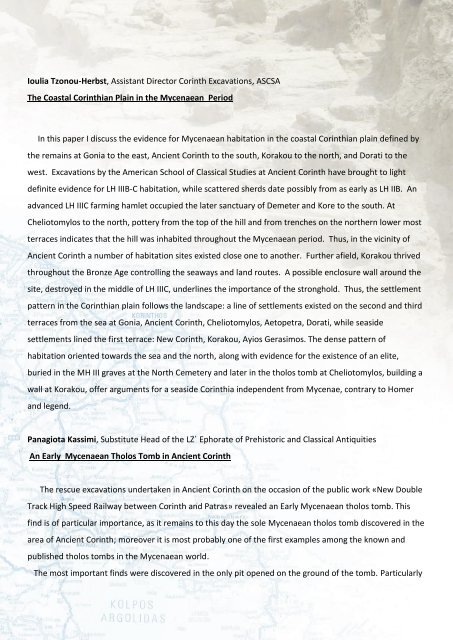ABSTRACTS - The American School of Classical Studies at Athens
ABSTRACTS - The American School of Classical Studies at Athens
ABSTRACTS - The American School of Classical Studies at Athens
You also want an ePaper? Increase the reach of your titles
YUMPU automatically turns print PDFs into web optimized ePapers that Google loves.
Ιoulia Τzonou-Herbst, Assistant Director Corinth Excav<strong>at</strong>ions, ΑSCSA<br />
<strong>The</strong> Coastal Corinthian Plain in the Mycenaean Period<br />
In this paper I discuss the evidence for Mycenaean habit<strong>at</strong>ion in the coastal Corinthian plain defined by<br />
the remains <strong>at</strong> Gonia to the east, Ancient Corinth to the south, Korakou to the north, and Dor<strong>at</strong>i to the<br />
west. Excav<strong>at</strong>ions by the <strong>American</strong> <strong>School</strong> <strong>of</strong> <strong>Classical</strong> <strong>Studies</strong> <strong>at</strong> Ancient Corinth have brought to light<br />
definite evidence for LH IIIB-C habit<strong>at</strong>ion, while sc<strong>at</strong>tered sherds d<strong>at</strong>e possibly from as early as LH IIB. An<br />
advanced LH IIIC farming hamlet occupied the l<strong>at</strong>er sanctuary <strong>of</strong> Demeter and Kore to the south. At<br />
Cheliotomylos to the north, pottery from the top <strong>of</strong> the hill and from trenches on the northern lower most<br />
terraces indic<strong>at</strong>es th<strong>at</strong> the hill was inhabited throughout the Mycenaean period. Thus, in the vicinity <strong>of</strong><br />
Ancient Corinth a number <strong>of</strong> habit<strong>at</strong>ion sites existed close one to another. Further afield, Korakou thrived<br />
throughout the Bronze Age controlling the seaways and land routes. A possible enclosure wall around the<br />
site, destroyed in the middle <strong>of</strong> LH IIIC, underlines the importance <strong>of</strong> the stronghold. Thus, the settlement<br />
p<strong>at</strong>tern in the Corinthian plain follows the landscape: a line <strong>of</strong> settlements existed on the second and third<br />
terraces from the sea <strong>at</strong> Gonia, Ancient Corinth, Cheliotomylos, Aetopetra, Dor<strong>at</strong>i, while seaside<br />
settlements lined the first terrace: New Corinth, Korakou, Ayios Gerasimos. <strong>The</strong> dense p<strong>at</strong>tern <strong>of</strong><br />
habit<strong>at</strong>ion oriented towards the sea and the north, along with evidence for the existence <strong>of</strong> an elite,<br />
buried in the MH III graves <strong>at</strong> the North Cemetery and l<strong>at</strong>er in the tholos tomb <strong>at</strong> Cheliotomylos, building a<br />
wall <strong>at</strong> Korakou, <strong>of</strong>fer arguments for a seaside Corinthia independent from Mycenae, contrary to Homer<br />
and legend.<br />
Panagiota Kassimi, Substitute Head <strong>of</strong> the LZ΄ Ephor<strong>at</strong>e <strong>of</strong> Prehistoric and <strong>Classical</strong> Antiquities<br />
An Early Mycenaean Tholos Tomb in Ancient Corinth<br />
<strong>The</strong> rescue excav<strong>at</strong>ions undertaken in Ancient Corinth on the occasion <strong>of</strong> the public work «New Double<br />
Track High Speed Railway between Corinth and P<strong>at</strong>ras» revealed an Early Mycenaean tholos tomb. This<br />
find is <strong>of</strong> particular importance, as it remains to this day the sole Mycenaean tholos tomb discovered in the<br />
area <strong>of</strong> Ancient Corinth; moreover it is most probably one <strong>of</strong> the first examples among the known and<br />
published tholos tombs in the Mycenaean world.<br />
<strong>The</strong> most important finds were discovered in the only pit opened on the ground <strong>of</strong> the tomb. Particularly

















